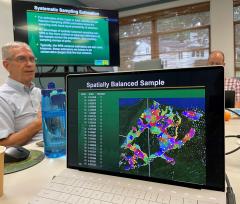SilvaCarbon training promotes best practices in national forest inventory design, implementation
WASHINGTON, DC—Global leaders in forest inventory design and implementation gathered in-person and online during the week of Aug. 28 to refine core statistical models for forest inventory sampling and to share lessons learned in inventory design and implementation. Forest inventories inform policy decisions and help countries better manage their forests, the effects of which contribute to global conservation efforts to mitigate the impacts of climate change.
Dr. Charles (Chip) Scott, retired USDA Forest Service SilvaCarbon program scientist, and Dr. Andrew (Andy) Lister, Northern Research Station Forest Inventory and Analysis, led the group of 12 professionals from five continents and nine countries. Over five days, Scott, Lister and trainee participants shared software tools and workflows designed to clarify statistical concepts, assess needs, estimate sample size, select the most efficient designs and produce estimates on the population sampled.
Training covered the integration of remote sensing platforms like Collect Earth Online—a tool presented by Wes Roberts from the Food and Agriculture Organization and developed with technical support from NASA, the Forest Service, partners in academia and others—to monitor land-use change with high-resolution imagery. Lauri Vesa from FAO introduced Open Foris Arena and Dr. Asdrúbal Calderón presented Silva Metricus. These tools, developed with Forest Service support, use forest inventory best practices to assist with data collection forms, data management, analysis and estimation. The group discussed the components of successful forest inventory projects and followed some well-defined steps outlined by the Voluntary Guidelines on National Forest Monitoring, an FAO best practices document that FIA staff helped develop.
Attendees brought a diversity of backgrounds and experiences from their work at FAO, the Forest Service and from universities, and they benefited from each other’s lessons learned. Participants departed the workshop with increased knowledge on inventory design and implementation and a greater understanding of the statistical concepts and methods that underlie inventory tools.
The training was part of a broader effort to make inventory design and implementation methods and educational tools more accessible to those working to support national forest inventory programs globally and to improve internal Forest Service monitoring processes by incorporating new perspectives and tools. Training participants are now equipped to be trainers in forest inventory design and implementation where they live.
There is a growing demand from countries for tools and analyses that can assist them in utilizing their National Forest Inventory data in a cost-effective manner. Many countries face challenges such as limited financial resources or staffing and access to forested areas; thus, they need efficient methods to leverage inventory data for improved forest and climate-related policy decisions.
The Forest Service is dedicated to applying knowledge globally and learning from its international partners.
Strengthening the capacity of individuals to design and analyze forest inventories enables more informed policy decisions and leads to better-managed forests. This collective endeavor contributes to global conservation efforts and helps mitigate the impacts of climate change.
This effort was funded by SilvaCarbon. SilvaCarbon is an interagency technical cooperation program of the U.S. government that works to enhance the capacity of tropical countries to measure, monitor, and report on carbon in their forests and other lands. To learn more about this mission please visit our website.


